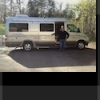
There’s about 3,000 people here and, like all such big gatherings, there are lots of folks to visit with, motorhomes to tour, evening entertainment programs and vendors to haggle with.
We spent a great night socializing with the Roadtrek International (RTI) FMCA chapter members, hanging out and sharing the fun things we do with our Roadtreks.I liked what John Macinnis from Ottawa, Ontario, Canada said: “We can do so many things and go so many places with our Roadtreks. This is all about sharing our travel experiences with the perfect touring vehicle.”
So we did just that. It rained. So two Roadtreks parked side by side, front to back and extended their awnings. About 20 of us congregated under the rain protection, sharing the places we’ve been and the adventures we have had. And the adventures we plan to have.
FMCA National President Charlie Adcock stopped by. He’s a huge supporter of RTI. “If it wasn’ t for Roadtrek International, the FMCA would not be what it is today,” he told me. The Roadtrek International chapter is the third largest chapter of the 80,000 member FMCA.
FMCA National President Charlie Adcock says Roadtrek members constitute the third largest chapter of the 80,000 member group.
My favorite vendor was Bike Friday, maker of the hand-built and customized folding bike you see me riding in the photo above. Bike Friday is an Oregon company and I was amazed at how well the small-wheeled bikes performed. They were fast, nimble and very comfortable. Both Jennifer and I bought one. From our Roadtrek Facebook Group, Jim Langely, a fellow Roadtrek owner and one of the top experts on cycling and all things that have to do with bicycles (see his books) gave me a thumbs up on the brand.
I’ve been looking for a way to add more exercise to our traveling and these bikes, which fold up so compactly, will get me moving. I’ve been trying to figure out for some time how we could take our bikes and once I saw how these fit so well in our StowAway2 cargo box, it was a no-brainer.
I rode it all around the campground last night. I can’t wait til I get it out in the boondocks.
Jennifer and I each got a Bike Friday.
My new Bike Friday
Mine and Jennifer’s new Bike Fridays in our StowAway cargo box.
The expo of RV related accessories, services and parts is always a big draw. I bought yet another supposedly kinkless water hose and some Velcro strips to keep it neatly and tightly wound. We’ll see. I am vowing to wind this new one correctly, the same way, every time.
Roadtrek is here, showing off the entire line. The local dealer is Guaranty RV Supercenters from Junction City, OR and I got a chance to visit with Sales Rep Matt Elliott. He says the Pacific Northwest and the whole west coast is a strong area for Class Bs thanks to the abundance of awesome places to camp, from Pacific shorelines to mountain boondocking. Roadtrek’s sales manager and VP Paul Cassidy is also here, along with Dawn and Alex from the Kitchener team. They stopped by to chat with some of the Roadtrek owners after the motorhome showcase displays closed for the night.
I looked but if there were other small motorhomes on display at the show here, they were hidden among the Class A skyscrapers.
Besides the new motorhomes and the vendor display there are seminars throughout the day, dozens of them on every possible topic of interest to RVers, from traveling to Alaska, to how to do basic repairs ,to technology for travelers ,to the pros and cons of fulltiming. I taught two seminars this week, one on smartphone apps for the open road and and one on the history of the Oregon Trail.
Jennifer and I met lots of folks interested in our Roadtreking experiences over the past couple of years. We did a lot of explaining how the two of us and our dog, Tai, manage to live in a 24 foot van.
I like to send them to this story about our top 10 rules for getting along in a motothome.
Rallies like this are a great time to connect with the larger RVing community, be they in Class A , C or B motorhomes. It reminds me if the pioneer mountain men who spent most of the year in the wilds, trapping and hunting and alone in the wilderness. Once a year, they’d gather for a reunion and gathering.
While they preferred solitude and independence most of the time, connecting with their extended community from time to time was always a highlight of the year for them. So it is for Jennifer and I and the FMCA reunions like this one.
We’re leaving here for Glacier National Park. Back to the wilds. But we’re refreshed and energized by the camaraderie we just experienced.
- Read more...
- 0 comments
- 2335 views

